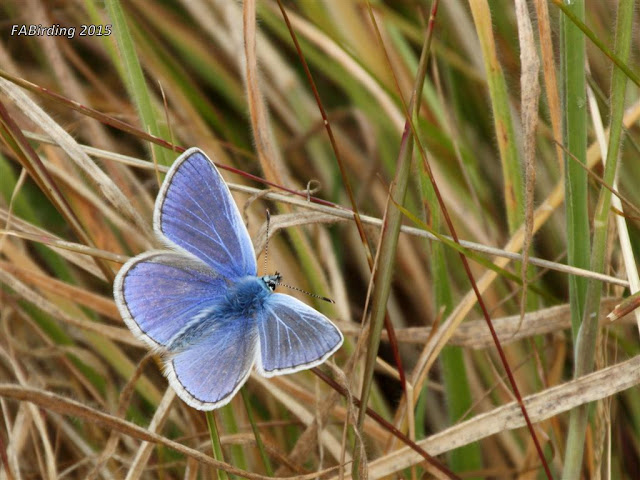Following a pre-booked appointment on Monday morning to obtain some advice and an estimate for some much needed and doubtless expensive improvements to our heating system I decided to head over to Denbies Hillside on the North Downs.
 |
| Chalkhill Blue (male) |
My ultimate quarry was the rarest of our downland blue butterflies on the edge of its European range in this area.
As I slowly descended the slope, with the sun hidden behind clouds, my initial views were only of the undersides of another species also characteristic of the warm chalk hillsides of southern England, a few Chalkhill Blue waiting for the sun to shine.
When the sun reappeared the flutters slowly emerged including Small Heath, Meadow Brown, Gatekeeper, Brimstone, Painted Lady plus a Spotted Skipper and then the hillside around me was alive with many Chalkhill Blues.
 |
| Chalkhill Blue (Polyommatus coridon) |
 |
Common Blue (Polyommatus icarus)
|
As my search continued across the hillside another blue species alighted close by but this turned out to be just a Common Blue (Polyommatus icarus).
I was beginning to get a little frustrated that I couldn't spot my ultimate quarry until I heard a comment between two ladies walking nearby indicating that they had just seen a different blue butterfly that they couldn't identify. Renewing my efforts I eventually found a few males of this stunning species with the distinctive black lines through the white fringes of the wings.
 |
| Adonis Blue (Polyommatus bellargus) |
With wings closed the Adonis is very similar to the Chalkhill but with wings open the males are easy to distinguish from one another. The image
(bottom right) in the above collage shows several of both species taking minerals from a patch of animal faeces.

Both species share other common factors. Their larval food plant is exclusively Horseshoe Vetch and their larvae are adopted by red
(Myrmica) or black
(Lasius) ants. The Adonis thrives in sward of 1-6cm and the local rabbit population certainly helps to maintain these conditions.
On a track beneath the hillside is a superb wood carving that depicts the life cycle of this fabulous blue flutter.
Having finally achieved my goal I climbed back up the steep slope and made my way home with a few decent images to share.
FAB.
Linking to:
Saturday's Critters













































